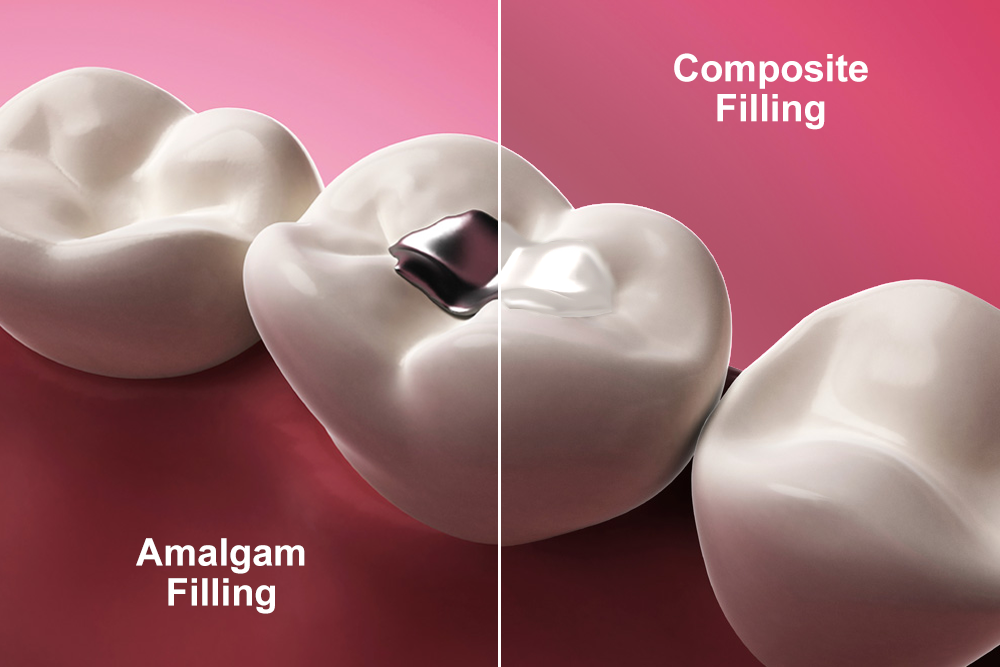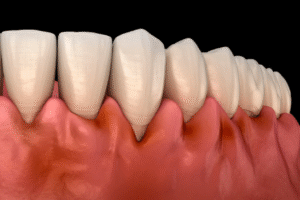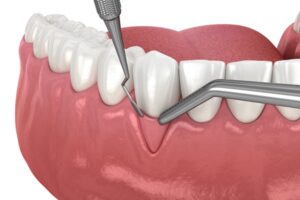Silver vs. Composite Fillings: What’s the Difference and Which is Best for You?

Silver vs. Composite Fillings: What’s the Difference and Which is Best for You?
Tooth Filling Options
Finding out you need a dental filling is a common experience—almost everyone goes through it at some point. However, when your dentist asks you to choose a material, you might feel confused. Which type is better? Which lasts longer? And which is safer?
In modern dentistry, the choice often comes down to two primary tooth filling options: Silver (Amalgam) and Composite (Tooth-Colored) Fillings.
Choosing between them is a big decision that affects your oral health, aesthetics, and budget. This guide breaks down the science, the aesthetics, and the cost difference to help you decide on the best dental filling material for your unique needs. As a leading provider of dental fillings Gandhinagar, we are here to provide clarity and expertise.
Let’s dive into the details of these two materials.
Understanding Silver Fillings (Amalgam)
Silver fillings, formally known as amalgam fillings, have been the backbone of restorative dentistry for well over a century.
What Exactly Is Amalgam?
The name “silver filling” is a bit misleading. Amalgam is actually a durable, stable mixture of metals, including powdered silver, tin, and copper, which are bound together by liquid mercury. When the dentist prepares the mixture, it starts as a soft paste that is pressed into the cavity, where it quickly hardens into a tough, resilient filling.
Amalgam Fillings Pros and Cons
Amalgam’s longevity and strength are its defining features, making it a reliable choice for areas of the mouth that handle heavy chewing forces.
Pros of Amalgam Fillings:
- Exceptional Durability: They are incredibly tough and resistant to wear, making them ideal for molars (back teeth).
- Cost-Effectiveness: They are typically the less expensive tooth filling option.
- Longevity: With good oral hygiene, amalgam fillings can last 10 to 15 years, or often even longer.
- Speed: They are quick and easy for a dentist to place, especially in hard-to-reach or moist areas.
Cons of Amalgam Fillings:
- Aesthetics: Their dark, metallic appearance is their biggest drawback, making them highly visible when you laugh or speak.
- Tooth Structure Removal: To hold the filling in place (mechanical retention), the dentist must remove more healthy tooth structure than with a composite filling.
- Temperature Sensitivity: Amalgam can expand and contract more than tooth structure in response to hot and cold temperatures, potentially leading to small cracks over time.
Understanding Composite Fillings (Tooth-Colored)
Composite fillings represent the modern approach to restorative dental care, offering a solution that prioritizes aesthetics and minimal invasiveness.
What is Composite Resin?
Composite resin is a blend of plastic (acrylic) and finely ground, glass-like particles (often quartz or silica). This mixture can be customized to precisely match the shade of your existing teeth, which is why they are often called “white fillings.”
Why Composite Fillings are the Modern Choice
The main advantage of composite is its ability to blend seamlessly with your natural smile. This makes them the go-to choice for front teeth or any visible surface.
Furthermore, unlike silver fillings, composite material is applied in layers and hardened using a special curing light. Crucially, the composite material chemically bonds to the tooth structure, creating a tight seal and requiring less initial drilling.
Pros of Composite Fillings:
- Superior Aesthetics: They are virtually invisible, making them the most aesthetically pleasing choice.
- Conservative Dentistry: Because they bond directly, the dentist only needs to remove the decayed portion of the tooth, preserving more healthy tooth structure.
- Versatility: They can be used not only for fillings but also to repair chipped, broken, or worn teeth.
Cons of Composite Fillings:
- Durability and Longevity: While they have improved dramatically, they may not last as long as amalgam in areas of extreme high stress, typically 5 to 10 years before they might need replacement.
- Procedure Time: The process of placing, layering, and bonding composite material is more technically sensitive and time-consuming than placing amalgam.
- Higher Cost: Due to the material’s complexity and the technical nature of the procedure, the composite fillings cost is generally higher than the silver option.
Head-to-Head: Silver vs. Composite Fillings
When comparing silver vs composite fillings, it helps to look at them side-by-side across the most important factors:
| Feature | Silver (Amalgam) Fillings | Composite (Tooth-Colored) Fillings |
| Appearance | Noticeable silver/dark color | Matches natural tooth color (invisible) |
| Material | Metal alloy (including mercury) | Resin and glass/quartz filler |
| Cost | Less expensive | Generally higher composite fillings cost |
| Tooth Prep | Requires more drilling for mechanical shape | Requires minimal drilling; bonds directly to tooth |
| Longevity | Excellent (10-15+ years) | Very good (5-10+ years) |
| Ideal Location | Back teeth (molars) under heavy load | Front teeth and visible chewing surfaces |
Addressing the Amalgam Safety Question
Many patients ask about the safety of amalgam due to its mercury content. It is important to know that dental amalgam has been extensively studied for decades, and major public health organizations around the world—including the World Health Organization and the U.S. FDA—consider it a safe and effective material for dental restorations. The mercury in amalgam combines with the other metals to form a stable, inactive compound.
However, if you have strong personal concerns about mercury or simply prefer a metal-free restoration, composite is an excellent and equally effective alternative.
Choosing the Best Dental Filling Material for You
The “best” filling isn’t a single material; it’s the one that meets your specific clinical needs, aesthetic goals, and budget. Here is how we determine the best dental filling material during your consultation at our clinic for dental fillings Gandhinagar:
1. Consideration: Location, Location, Location
- Visible Teeth (Front & Premolars): This is where composite is the undisputed winner. An amalgam filling in the smile zone would be a major aesthetic compromise, making composite the default choice.
- Non-Visible Molars (Back Teeth): This area bears the most chewing force. While amalgam has traditionally been the strongest, modern composites are strong enough for most moderate-sized fillings here. If the cavity is extremely large, the dentist may recommend a crown, or, in some specific cases, may still lean toward the strength of amalgam.
2. Consideration: Size of the Cavity
- Small to Medium Cavities: Composite is ideal. The bonding process is superior for preserving healthy tooth structure.
- Very Large Cavities: If the decay is extensive, the tooth needs maximum support. Amalgam provides bulk strength, but sometimes an even better solution is a tooth-colored inlay, onlay, or a full crown, which provide superior long-term protection compared to any simple filling.
3. Consideration: Budget and Insurance
While we always prioritize the health and longevity of your restoration, composite fillings cost must be acknowledged.
- Many insurance plans may cover amalgam fillings fully, but often only partially cover composite fillings, particularly on back teeth.
- If budget is the primary constraint and the filling is located far back where visibility is not an issue, an amalgam filling remains a clinically sound and affordable choice.
Ultimately, the choice of the best dental filling material is a partnership between you and your dental professional. During your visit for dental fillings Gandhinagar, we will examine the extent of the decay, assess the bite forces on the tooth, and discuss your personal preferences before making a joint recommendation.
Maintenance and Care for Your Tooth Filling Options
No matter which of the tooth filling options you choose, the lifespan of your restoration depends heavily on your daily habits.
- Brush and Floss Consistently: Keep the area around the filling clean to prevent new decay from forming.
- Avoid Excessive Stress: Try not to chew on ice, hard candies, or use your teeth as tools. This stress can chip or fracture the filling material, regardless of whether it’s silver or composite.
- Routine Check-ups: Ensure you schedule biannual check-ups at your dental fillings Gandhinagar clinic. We will examine the margins of the filling to ensure it is sealed properly and address any wear or leakage before it becomes a problem.
Composite fillings can sometimes stain over time (similar to natural teeth) due to coffee, tea, or red wine. Amalgam fillings, while not staining, can sometimes cause a gray discoloration in the surrounding tooth over many years.
Conclusion: Making Your Informed Choice
When weighing silver vs. composite fillings, you are essentially balancing maximum durability (silver) against superior aesthetics (composite). Both are highly effective tooth filling options for restoring decayed teeth, but the choice is always customized.
At Nova Dental Hospital, we offer both materials and will guide you through the process, ensuring you receive the best dental filling material that fits your clinical and lifestyle needs.
If you are currently experiencing tooth pain, suspect you have a cavity, or are ready to replace old, dark silver fillings with modern, tooth-colored composite, don’t wait.
Ready to discuss your options for dental fillings in Gandhinagar? Schedule your personalized consultation today!










